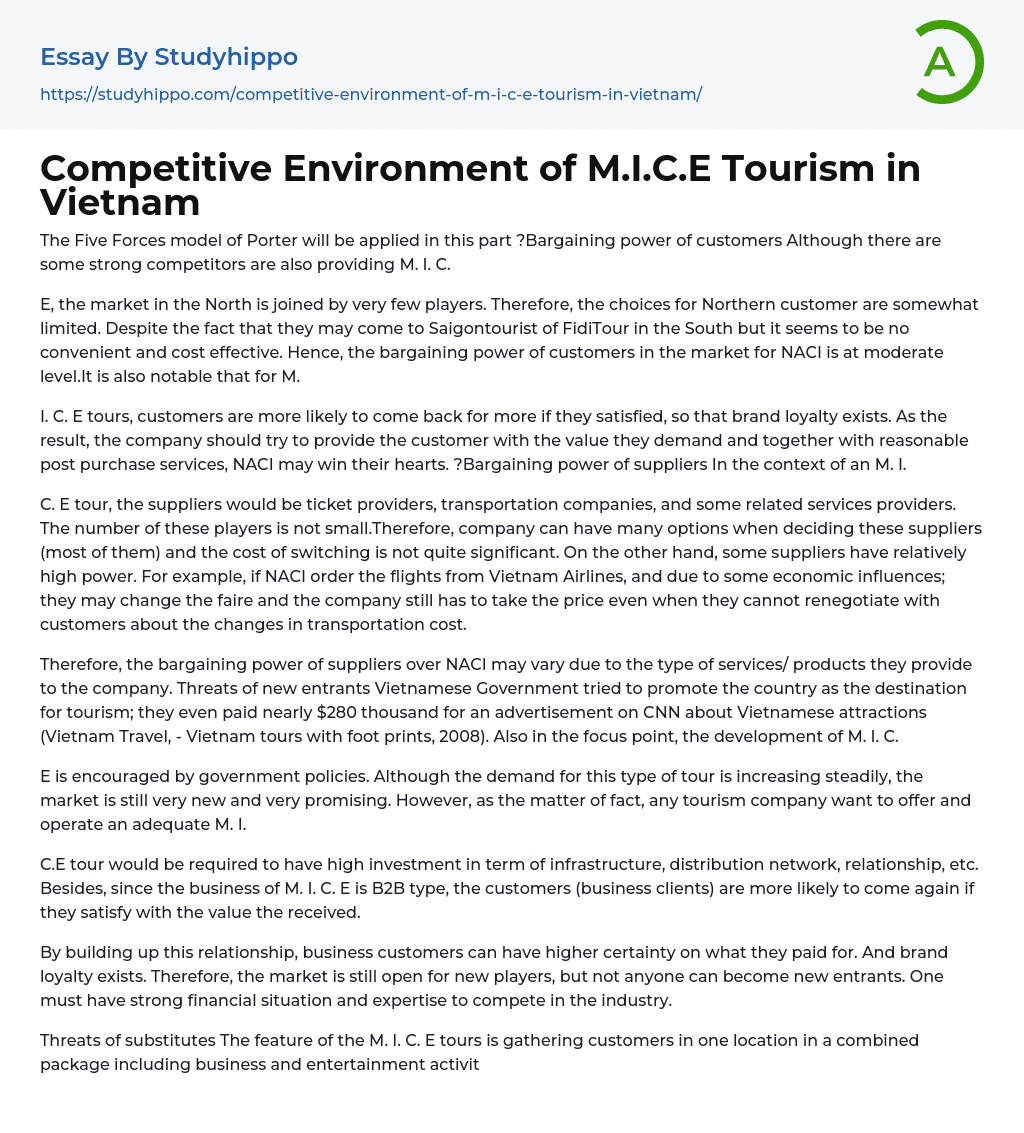

Competitive Environment of M.I.C.E Tourism in Vietnam Essay Example
This section will implement Porter's Five Forces model, focusing on the bargaining power of customers. Despite the presence of powerful competitors offering M.I.C., it will be taken into consideration.
There are only a few players in the Northern market, resulting in limited choices for Northern customers. Although they can travel to Saigontourist or FidiTour in the South, it may not be convenient and cost-effective. As a result, the bargaining power of customers in the NACI market is moderate. Additionally, it is noteworthy that this also applies to M.
I. C. E tours recognizes the importance of customer satisfaction and brand loyalty in ensuring repeat business. To achieve this, the company must prioritize meeting customer expectations and providing adequate post-purchase services in order to win their loyalty. Additionally, considering the bargaining power of suppliers is critical in M. I. context
....
When it comes to C.E. Tour, suppliers include those who provide tickets and transportation, as well as related services. With many options available for selecting these suppliers and low switching costs, the company has some flexibility. However, some suppliers have more power, such as Vietnam Airlines. If economic circumstances lead to changes in flight fares, the company may be unable to renegotiate with customers regarding transportation cost changes and will be obligated to pay the higher price.
As for NACI, it's important to consider that the bargaining power suppliers hold over them may differ depending on the nature of the services or products they provide. Additionally, there is a threat of new competitors entering the market, as evidenced by the Vietnamese Government's efforts to promote tourism in the country through advertising and investment in infrastructure. This includes the development
of M.I.C. technology.
Despite being a relatively new market, the demand for M.I. tours is on the rise and government policies are providing encouragement for companies interested in offering these tours. Nevertheless, any tourism company seeking to provide sufficient amenities for M.I. tourism must consider this matter carefully.
For a successful C.E tour venture, considerable investment is needed in terms of infrastructure, distribution networks, and relationships. In addition, since M.I.C.E operates as B2B business, business clients are more likely to return if they are satisfied with the value they receive.
Developing a strong relationship with business customers leads to increased assurance regarding their payments and promotes brand loyalty. Consequently, the market remains potentially viable for newcomers, though only those with robust financial standings and industry expertise can successfully enter and compete.
One advantage of M.I.C.E tours is that they bring together customers from different locations for a package that combines business and entertainment activities. These tours have unique features that distinguish them from other tours in the industry, which means that there is no direct substitute to worry about. However, in a challenging economy, companies may look to cut costs, including their expenditure on M.I.C.E activities.
With the significance of I.C.E tours, companies may consider utilizing advancements in information technology rather than relying on traditional methods.
The I.C.E tour showcases the cutting-edge technology called Voice IP, which enables people to communicate and have virtual conferences over the internet from different locations, including video conferencing. This eliminates the need for physical gatherings.
Although virtual communication technology offers advantages such as lower cost and convenience, it lacks the entertainment elements of traditional communication and fails to have the same effect as
face-to-face interactions. Thus, it is not clearly a substitute for personal contact. In terms of competitive rivalry within the industry, Saigontourist has operated in South Vietnam for over 30 years and is widely recognized as one of the largest tourism companies in Vietnam. Additionally, being a member of M.I.C adds to their strengths and achievements.
One advantage in the market for Fiditour South Vietnam is their expertise in East Vietnam. Established in 1989 and previously known as Tan Dinh Trade ; Travel Service Co, they have extensive experience and commercial backing. Fiditour is a renowned tourism company with a well-known name in several overseas countries. CITE South Vietnam was established in 1999 and was awarded Best Travel Agency Indochina 2008 by Travel Weekly (Asia). Although some tourism companies in North Vietnam offer tours with similar features to M.I.C., these two agencies stand out in the South.
However, none of NACI's competitors in the North of Vietnam were able to offer customers a complete package. In comparison to the Southern competition, NACI's parent company has a well-established network of relationships. Additionally, NACI itself is completing construction on a five-star resort by 2008. It is important to note that NACI focuses mainly on the North of Vietnam, while the other three major competitors operate further South. Therefore, it is reasonable to assume that the market in the North remains open for NACI to introduce this new tour.
- flood essays
- Traffic essays
- Renewable Energy essays
- Carbon Dioxide essays
- Greenhouse Gas essays
- Ecology essays
- Pollution essays
- Environmental Issues essays
- Air Pollution essays
- Nature essays
- Water Pollution essays
- Climate essays
- Hurricane essays
- Tornado essays
- Tsunami essays
- Endangered Species essays
- Deforestation essays
- Environmental Protection essays
- Sustainability essays
- Stream essays
- Environmental Disaster essays
- Sustainable Development essays
- Environment Pollution essays
- Plastic Pollution essays
- Animal Welfare essays
- Zoo essays
- Plastic essays
- Waste Management essays
- Climate Change essays
- Global Warming essays
- Conservation essays
- Recycling essays
- Oxygen essays
- Atmosphere essays
- Coral Reef essays
- Desert essays
- Earth essays
- Ocean essays
- Lake essays
- Sea essays
- Biodiversity essays
- Natural Environment essays
- Forest essays
- Soil essays
- Water essays
- Rainbow essays
- Ecosystem essays
- Volcano essays
- Wind essays
- Forestry essays



